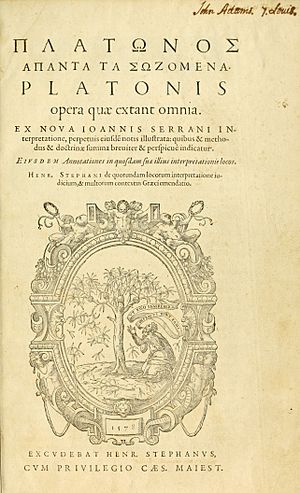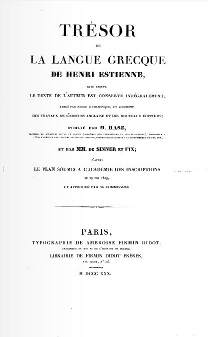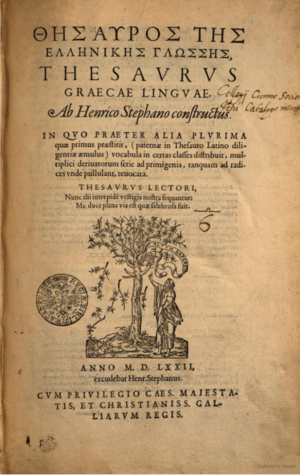Henri Estienne facts for kids
Henri Estienne (1528 or 1531–1598) was a famous French printer and scholar. He studied classic languages like Latin and Greek. He was the oldest son of Robert Estienne, who was also a well-known printer. Henri took over his father's printing business in 1559.
One of his most famous works was the Thesaurus graecae linguae. This was a huge dictionary of the Greek language, printed in five volumes. It was so good that no other Greek dictionary was as complete for 300 years!
Henri Estienne also published many books by Greek writers. His editions of Plato's works are still used today. Scholars refer to specific parts of Plato's writings using "Stephanus numbers," which come from Henri Estienne's editions. He died in Lyon in 1598.
Contents
Life of Henri Estienne
Henri Estienne was born in Paris in either 1528 or 1531. His father taught him Latin, Greek, and Hebrew. He also learned about printing. He even learned some Latin as a child because it was a common language in his home.
Other French scholars also helped educate him. When he was 18, he started working for his father's printing business. He helped check old handwritten books.
In 1547, Henri traveled to Italy, England, and Flanders. This was part of his training. He learned Spanish and collected old manuscripts for his father's printing press. Around 1551, his family moved to Geneva. They left Paris to avoid religious problems. In Geneva, Henri translated a religious book by John Calvin into Greek.
Early Printing Work
In 1554, Estienne published his first independent book, the Anacreon. After this, he went back to Italy. He helped another famous printing company called the Aldine Press in Venice. While in Italy, he found an important old text by Diodorus Siculus in Rome. He returned to Geneva in 1555.
By 1557, he likely had his own printing shop. He called himself the "Parisian printer." The next year, a wealthy supporter named Ulrich Fugger helped him with money. Estienne then published a collection of writings from early Greek thinkers.
Taking Over the Business
In 1559, Henri's father died. Henri then took over the family printing business. He also became the official printer for the Republic of Geneva. That same year, he published his own Latin translation of Sextus Empiricus's works. He also printed an edition of Diodorus Siculus.
In 1565, he printed a large French Bible. The next year, he published his best-known French book, the Apologie pour Hérodote. Some parts of this book caused problems with the religious leaders in Geneva. He had to remove those pages. But the book became very popular. Twelve editions were printed within 16 years.
His Most Famous Work
His most celebrated work was the Thesaurus graecae linguae, or Greek thesaurus. It came out in five volumes in 1572. This huge dictionary continued his father's work on a Latin thesaurus. It became the main source for Greek language studies for over 300 years.
However, the thesaurus was very expensive. This made it hard to sell many copies. Later, a shorter version was printed. Estienne also published two Greek versions of the New Testament in 1576 and 1587. He also printed works by famous authors like Herodotus, Plato, Horace, and Virgil. He was the first to print the play Agamemnon as a separate book.

In 1578, he published a very important edition of all of Plato's works. This edition was translated by Jean de Serres. It is the reason we have the standard "Stephanus numbers" that scholars use today to refer to Plato's writings.
Later Life and Travels
In 1578, another one of his books, Deux Dialogues du nouveau françois italianizé, caused more disagreements with religious leaders. To avoid trouble, he went to Paris and stayed at the French court for a year. When he returned to Geneva, he was put in prison for a week.
After this, he traveled a lot. He visited cities like Basel, Heidelberg, and Vienna. He also spent time in Paris and other parts of France. He made these trips to find people who would support him and buy his books. The large amounts of money he spent on books like the Thesaurus and Plato's works had almost ruined him financially. In 1594, he published a concordance of the New Testament.
He visited the University of Montpellier, where his son-in-law, Isaac Casaubon, was a professor. Then he started for Paris. He became sick in Lyon and died there in January 1598.
Family Life
Henri Estienne was married three times. He had 14 children, but only three were still alive when he died. His daughter married the famous scholar Isaac Casaubon.
His son Paul (born 1567) took over the printing presses in Geneva with Casaubon. Paul later moved to Paris. Paul's son Antoine became the "Printer to the King" in Paris. However, Antoine's death in 1674 ended the Estienne family's printing business, which had lasted for almost 200 years.
Legacy and Importance
Many scholars believe Henri Estienne was the most important printer in the Estienne family. He is seen as one of the "greatest and last scholarly editors and publishers of the Renaissance." He helped preserve and share many important classical texts.
See also
 In Spanish: Henri Estienne para niños
In Spanish: Henri Estienne para niños
- Stephanus pagination
- Jean de Serres, who worked with Henri Estienne on the Plato edition
- Comparison of Ancient Greek dictionaries



